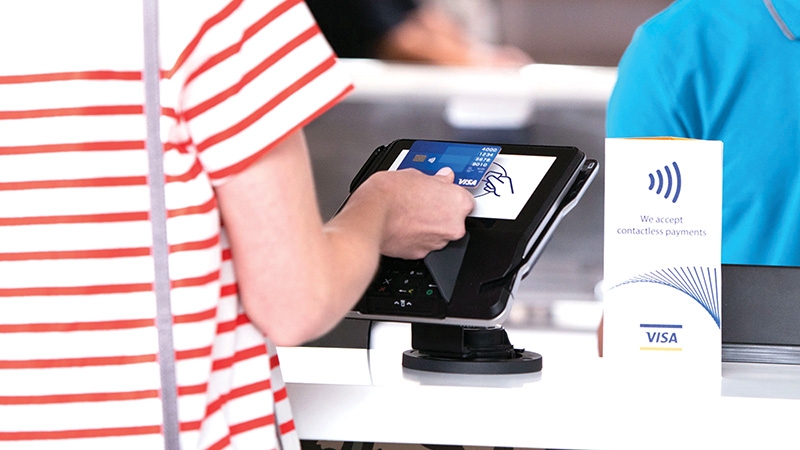Securing the country’s digital payments future
 |
| Many Vietnamese people are already using smartphones, and are thus more likely to use digital payment methods |
Over the last couple of years, there has been an expansion in the forms of digital payments in Vietnam including the likes of credit cards, internet banking, mobile wallets, and digital payment apps among others. Thus, Vietnamese consumers are increasingly embracing digital payment as a faster and more convenient way to pay, with consumers using cashless payments more often for in-store and online purchases.
 |
| People, businesses, and institutions thrive when barriers to progress are low and trust is high. Preserving that trust requires driving innovation and choice, and redoubling our commitment to security. There has never been a better time to lead and drive change in payment security which can be a catalyst for growth. Paul Fabara - Chief risk officer, Visa |
Meanwhile, the Vietnamese government has also targeted reducing the ratio of transactions made with cash from 90 per cent in 2016 to below 10 per cent by the end of 2020. About two-thirds of the population are online and by 2018, 72 per cent of the population already owned smartphones. E-commerce has grown at a phenomenal rate of 25-30 per cent in recent years, as the expanding affluent class is more willing to click and spend. All signs are pointing to Vietnam’s remarkable potential to go cashless.
Market research firm Statista found that Vietnam’s total transaction value in the digital payments segment amounts to $8.52 billion in 2019. Total transaction value is expected to show a compound annual growth rate of 12.7 per cent between 2019 and 2023, resulting in the amount of $13.74 billion by 2023.
However, the increasing number of cashless transactions is also a major factor behind the rising demand for payment security. Visa’s Consumer Payment Attitude study points out that security remains a key consideration for Vietnamese consumers to go cashless. When asked specifically about their top three concerns when using their mobile phones to make payments, the majority of consumers in Vietnam responded with losing a phone or having it stolen, it being hacked or intercepted, and malware or viruses being installed on it.
To strengthen payment security in support of Vietnam’s cashless transformation, Visa launched its Future of Security Roadmap for Vietnam in March 2019. The roadmap focuses on a number of key initiatives which will enable security to evolve at the same pace as the technologies changing the way consumers pay.
As of present, the digital payment industry has seen significant advances in risk scoring for fraud prevention, encryption, and industry specifications for securing new ways to pay to help protect the billions of transactions made by consumers. As the end of a decade approaches, the continued expansion of digital payments in Vietnam and around the world will continue to present challenges and opportunities for the industry. Visa, a leading payment technology company has made predictions for payment security to keep in mind for the next decade.
Seeing the future
Data breaches will continue to happen, forcing the adoption of smarter and more dynamic security to protect data and manage fraud. The best defence is to assume the organisation is a target and take proactive steps to avoid falling victim or prevent the use of stolen data in the systems.
According to Visa, we will see significant growth in the adoption of payment tokens and the updated EMV 3-D Secure specification globally. Payment tokens help make transactions safer by eliminating the transfer of actual payment data for e-commerce and mobile payments, and can deliver a seamless yet secure digital payment experience. Meanwhile, the updated 3-D Secure specification enables the real-time exchange of 10 times more contextual data between merchants and financial institutions to improve decision-making so both parties can better manage fraud in digital channels while optimising sales.
Another global trend is “digital identities” which can be used to deliver a better customer experience. It is clear that traditional approaches to online payment like manually entering static passwords and payment credentials for every purchase offer incremental security for digital channels. Fortunately, digital identities make payments faster, easier, and more secure when using computers, mobile devices, apps, wearables, and future IoT devices.
As fraud threats persist, digital identities can end the use of passwords so consumers can shift to more secure methods of authentication such as face, fingerprint, or voice recognition. European consumers will begin to experience Strong Customer Authentication, European Union requirements for multiple layers of consumer verification for digital transactions. As many thousands of financial institutions and merchants meet these requirements in Europe, global companies may look to extend the most innovative authentication solutions to other markets, including Vietnam.
As consumers globally also demand greater speed, merchants and financial institutions will have to respond with faster and safer ways to pay. This is one reason why Visa is exploring innovations ranging from biometric payment authentication and wearables to new mobile applications like digitally-issued cards at the Tokyo 2020 Olympics and Paralympics Games.
Real-Time Payments (RTP) is another global initiative that has gained momentum over the past few years. However, this payment method will require a new approach to fraud prevention. It is worth noting that consumer expectations of speed and convenience have extended to business-to-business payments and disrupted wire transfers and check payments with instant payments. However, speed and convenience cannot come at the expense of security.
As payment volumes grow among RTP networks and peer-to-peer applications, the seen and unforeseen vulnerabilities in the systems will have to be addressed as quickly. Therefore, RTP providers and financial institutions will need to think differently and will likely collaborate with trusted partners in payment security to address the challenge.
In the right hands
Furthermore, the growing use of AI will continue to fuel new products and services in payments and have a significant impact on society. However, it will also introduce tremendous challenges due to its potential use by threat actors. History shows that good intentions can be manipulated by nefarious individuals and groups. For example, the internet splintered to become the surface web, dark web, and deep web; and social media is being used beyond its original intent to simply connect friends and family. The challenge of AI next year and beyond will require a collective effort across industries to limit the darker side of the technology to ensure it is used to deliver opportunities and improvements to society.
Above all, users will continue to be the weakest link in the digital process. Technology has been trying to solve this issue for a long time – from spell check in word processors and email applications to automatic braking in some of today’s cars. Advancements in payment security will continue to help drive down fraud as the EMV chip did for counterfeit fraud but technology can only do so much as it still needs to be implemented by people and people make mistakes.
More importantly, social engineering continues to evolve as it preys on the unsuspecting or those with their guard down. All it takes is one person to fall prey to put an entire organisation or network at risk. The industry needs to empower users with education and tools since they are often the first line of defence.
People, businesses, and institutions thrive when barriers to progress are low and trust is high. Preserving that trust requires driving innovation and choice, and redoubling our commitment to security. There has never been a better time to lead and drive change in payment security which can be a catalyst for growth. By drawing on the lessons from past years, we can both address future challenges and capitalise on the opportunities stemming from our increasingly digitised society.
What the stars mean:
★ Poor ★ ★ Promising ★★★ Good ★★★★ Very good ★★★★★ Exceptional
Related Contents
Latest News
More News
- Home Credit Vietnam brings financial literacy closer to women and students (November 20, 2025 | 11:25)
- MB partners with Visa, KOTRA to launch new MB Visa Hi BIZ card (November 20, 2025 | 11:24)
- VPBank upgrades core banking with Temenos and Systems Limited (November 14, 2025 | 17:54)
- CPO Home Credit shares how to build an AI-driven but human-centric workplace (October 30, 2025 | 09:56)
- VIB hits $267.4 million in pre-tax profit over first nine months (October 29, 2025 | 12:12)
- UOB Vietnam elevates retail banking experience with enhanced credit card suite (October 24, 2025 | 09:50)
- PVcomBank offers 20 per cent cashback on VNPAY-QR payments (October 20, 2025 | 17:43)
- Vietnam’s banking sector enters data-driven era (September 30, 2025 | 16:33)
- Ant International becomes first foreign partner of China’s CPG (September 22, 2025 | 17:58)
- VIB unveils Smart Duo to maximise savings and spending returns (September 22, 2025 | 11:22)

 Tag:
Tag:





















 Mobile Version
Mobile Version